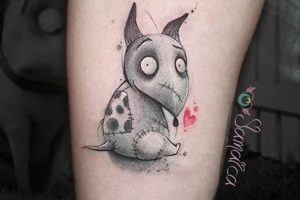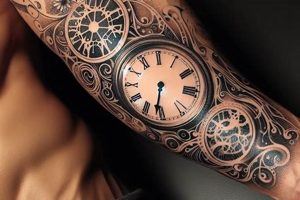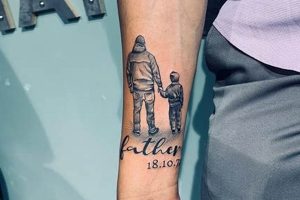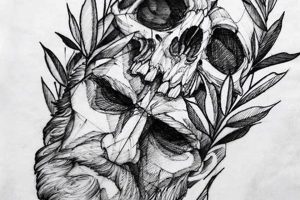Matching or complementary ink designs chosen by fathers and sons represent a permanent, visual expression of their bond. These designs can range from simple, shared symbols to elaborate, interconnected artwork, often reflecting shared interests, values, or memories. For example, a father and son might choose matching nautical stars, representing a shared love of sailing, or complementary designs like a tree and its branch, symbolizing lineage and connection.
Permanent body art offers a powerful way to commemorate and celebrate familial relationships. The collaborative process of selecting and obtaining matching or complementary tattoos can strengthen the father-son connection, providing a shared experience and lasting reminder of their mutual affection. Historically, tattoos have signified belonging and kinship within various cultures, and this tradition continues to resonate in contemporary society through familial ink. Choosing designs that hold personal meaning adds another layer of significance, transforming the tattoos into cherished symbols of a unique relationship.
This exploration will delve into various design categories, from symbolic representations of strength and guidance to shared hobbies and inside jokes. Practical considerations such as placement, size, and style will also be addressed to provide comprehensive guidance for those contemplating these meaningful expressions of familial bonds.
1. Matching Designs
Matching designs represent a powerful expression of unity and shared identity within the context of father-son tattoos. Choosing identical or nearly identical artwork symbolizes a deep connection and shared values, creating a visual representation of their bond. This approach can amplify the emotional impact of the tattoos, serving as a constant reminder of their close relationship. Examples include matching Celtic knots symbolizing enduring connection, identical minimalist lines representing shared journeys, or matching depictions of a significant date or coordinate.
The selection of a matching design often reflects shared interests or experiences. A shared passion for music might lead to matching musical notes or instruments, while a love for the outdoors could inspire identical mountain range silhouettes. The act of choosing these designs together strengthens the father-son bond, providing a collaborative experience and lasting memory. Practical considerations include ensuring the chosen design scales appropriately for different body placements and ages. A simpler design might be more suitable for smaller areas like the wrist or ankle, while larger, more detailed designs might be better suited for the back or chest.
Matching tattoos offer a distinct visual statement of the father-son relationship. While stylistic choices can vary widely, from minimalist linework to intricate realism, the core concept of shared imagery reinforces their connection. Challenges might arise in achieving perfect symmetry or identical execution, particularly with highly detailed designs. However, minor variations can sometimes add a unique touch, reflecting individual personalities while maintaining the overarching theme of unity.
2. Complementary imagery
Complementary imagery offers a nuanced approach to father-son tattoos, emphasizing interconnectedness rather than identicality. Unlike matching designs, complementary tattoos utilize distinct yet related images, symbolizing the individual roles and contributions within the relationship while reinforcing the underlying bond. This approach allows for greater creative expression and personalization, reflecting the unique dynamic between father and son. A classic example is the tree and leaf motif, where the father might bear the image of a strong, established tree, while the son carries the image of a leaf, representing growth and connection to the familial roots. Other examples include a lock and key, a sun and moon, or a compass and map, each pair representing a distinct yet interconnected relationship.
The strength of complementary imagery lies in its ability to capture the distinct personalities and roles within the father-son dynamic. It acknowledges individuality while simultaneously celebrating the enduring connection. The choice of imagery can reflect shared values, hobbies, or inside jokes, adding a layer of personal significance. A father and son who share a love of fishing might choose a fishing rod and a hooked fish, or a pair of playing cards representing a shared passion for poker. This personalized approach enhances the emotional resonance of the tattoos, transforming them into a unique narrative of their relationship. Furthermore, complementary designs offer greater flexibility in terms of placement and size, allowing for more intricate and personalized artwork.
Careful consideration of symbolism and visual balance is crucial when selecting complementary imagery. The chosen designs should harmoniously represent the individuals and their connection, creating a cohesive visual narrative. While this approach offers greater creative freedom, it also presents the challenge of selecting imagery that resonates with both individuals and effectively conveys the intended message. The selection process itself can be a bonding experience, fostering communication and understanding between father and son as they explore the symbolism and personal significance of different design options. Ultimately, complementary imagery offers a powerful and personalized way to celebrate the unique bond between a father and his son, transforming their shared history and connection into a lasting work of art.
3. Personalized Symbols
Personalized symbols elevate father-son tattoos beyond generic designs, imbuing them with unique meaning derived from shared experiences, inside jokes, or significant life events. This personalization transforms the tattoos into intimate expressions of their specific relationship, unavailable to anyone else. A shared love for a particular film might lead to matching or complementary tattoos featuring a quote or iconic imagery. A significant date, such as the day they climbed a mountain together, can be incorporated into the design, commemorating a shared achievement. Inside jokes, represented through symbolic imagery, create a private language understood only by the father and son, further strengthening their bond. These personalized symbols can range from simple objects like a favorite childhood toy to more complex representations of shared values or beliefs.
The selection of personalized symbols often involves a collaborative process, requiring open communication and reflection on shared memories. This process itself can be a valuable opportunity for strengthening the father-son connection, fostering deeper understanding and appreciation for their shared history. For instance, a father and son might choose matching tattoos of a compass pointing towards their family home, symbolizing their shared roots and sense of belonging. A specific type of flower might represent a cherished memory of a family vacation, while a geometric pattern could be designed using their initials, creating a unique and meaningful symbol of their connection. These personalized touches transform the tattoos into a visual representation of their shared narrative, creating a lasting testament to their bond.
The effectiveness of personalized symbols hinges on their ability to evoke shared memories and emotions. While simpler designs might be easier to execute, more complex symbols often carry greater emotional weight. The challenge lies in finding a balance between visual appeal and personal significance, ensuring the chosen symbols resonate with both individuals while remaining aesthetically pleasing. Ultimately, personalized symbols provide a powerful means of expressing the unique and intimate bond between a father and son, turning their shared experiences into a lasting work of art.
4. Meaningful Placement
Meaningful placement significantly impacts the overall effect of father-son tattoos, transforming them from simple body art into powerful statements of connection. Placement choices can amplify the symbolism of the chosen design, reflecting the nature of the relationship and the individuals’ personalities. A discreet placement, such as the inner wrist or ankle, might symbolize a private, intimate bond, while a more visible location, like the forearm or shoulder, could represent a proud declaration of their connection. Considerations include pain tolerance, as certain areas are more sensitive than others, and lifestyle factors, such as professional dress codes. For instance, a father working in a formal environment might opt for a placement easily concealed by clothing, while a son in a more creative field might embrace a more visible location. The size and complexity of the design also influence placement choices, with larger, more detailed pieces often requiring more surface area.
Placement can also enhance the visual narrative of the chosen design. A father might choose to place a tattoo representing strength and protection over his heart, symbolizing his commitment to his son. A son might place a tattoo representing guidance and respect on his forearm, visually connecting it to the father’s similar placement. The placement itself can become part of the story, adding another layer of meaning. For example, matching tattoos on the left ring finger, where wedding bands are traditionally worn, could symbolize the enduring and unbreakable bond between father and son. Similarly, tattoos placed over a scar might represent healing and growth, signifying the strength of their relationship in overcoming challenges.
Thoughtful placement enhances the personal significance and emotional resonance of father-son tattoos. While practical considerations are important, the ultimate goal is to choose a location that amplifies the symbolism of the design and reflects the unique dynamic of their relationship. Challenges might include limitations due to body shape or existing tattoos. Careful planning and consultation with a skilled tattoo artist are essential to ensure the chosen placement complements the design and fulfills the intended message. Ultimately, meaningful placement transforms father-son tattoos into powerful, personalized statements of connection, creating lasting reminders of their shared bond.
Tips for Choosing Father-Son Tattoos
Selecting meaningful and well-executed tattoos requires careful planning and consideration. These tips provide guidance for fathers and sons embarking on this shared journey, ensuring a positive and fulfilling experience.
Tip 1: Collaborative Design Selection: Open communication is paramount. Engage in thorough discussions about design preferences, symbolism, and personal significance. Consider creating a mood board or sharing design inspirations to ensure alignment.
Tip 2: Research Experienced Artists: Seek skilled artists specializing in the desired style. Review portfolios and client testimonials to gauge their expertise and ensure their artistic vision aligns with the project’s goals.
Tip 3: Prioritize Proper Placement: Consider visibility, pain tolerance, and lifestyle factors when selecting placement. Discuss options with the chosen artist to determine the most suitable location for the desired design and size.
Tip 4: Emphasize Meaningful Symbolism: Opt for designs that resonate with both individuals, reflecting shared values, memories, or inside jokes. Personalized symbols add depth and significance to the tattoos.
Tip 5: Plan for Scalability: Ensure chosen designs adapt well to different body sizes and placements. Consider how the tattoos might age over time and choose designs that maintain their visual appeal.
Tip 6: Factor in Budget and Time Commitment: High-quality tattoos require investment. Establish a realistic budget and be prepared for multiple sessions, especially for larger or more complex designs.
Tip 7: Prioritize Aftercare: Follow the artist’s aftercare instructions diligently to ensure proper healing and prevent complications. This includes keeping the tattoo clean, moisturized, and protected from sun exposure.
Careful consideration of these tips ensures a positive and fulfilling experience, resulting in meaningful tattoos that celebrate the unique father-son bond for years to come.
By thoughtfully addressing these considerations, individuals can embark on this journey with confidence, creating lasting tributes to their connection.
Frequently Asked Questions
This section addresses common inquiries regarding father-son tattoos, providing clarity and guidance for those considering this meaningful expression of familial bonds.
Question 1: What are the most popular design choices for father-son tattoos?
Popular choices include matching or complementary symbols of strength, guidance, and protection, such as lions, compasses, anchors, and trees. Geometric patterns, meaningful quotes, and shared hobbies also serve as common design inspirations.
Question 2: How can individuals ensure their chosen designs remain meaningful over time?
Selecting timeless imagery grounded in shared values and experiences contributes to long-term meaning. Avoiding trendy or overly specific pop culture references can help ensure the tattoos remain relevant throughout life.
Question 3: What factors influence the cost of father-son tattoos?
Cost depends on factors such as design complexity, size, artist experience, and studio location. Detailed, large-scale pieces by renowned artists typically command higher prices than simpler, smaller designs.
Question 4: What steps can individuals take to minimize pain during the tattooing process?
Choosing a less sensitive body area can reduce discomfort. Adequate rest, hydration, and avoiding alcohol or caffeine before the appointment can also contribute to a more comfortable experience. Topical numbing creams, when approved by the artist, might offer additional relief.
Question 5: What is the typical healing time for a tattoo, and how can proper aftercare be ensured?
Healing typically takes several weeks. Diligent aftercare is crucial for optimal healing and preventing infection. Following the artist’s instructions regarding cleaning, moisturizing, and sun protection promotes proper healing.
Question 6: Can tattoos be modified or removed if desired?
Modification or removal is possible, though laser removal can be costly and time-consuming. Consulting with a skilled tattoo artist or removal specialist is recommended to discuss available options and associated risks.
Careful consideration of these frequently asked questions ensures individuals approach the process of selecting and obtaining father-son tattoos with informed awareness.
The subsequent sections will offer a curated gallery of inspiring design concepts, providing further guidance and visual inspiration for those embarking on this meaningful journey.
Father Son Tattoo Ideas
This exploration has delved into the multifaceted nature of father-son tattoo ideas, examining various design approaches, symbolic considerations, and practical aspects. From matching designs emphasizing unity to complementary imagery celebrating individuality within the bond, the potential for meaningful expression is vast. Personalized symbols drawn from shared experiences add further depth and significance, transforming these permanent markings into powerful narratives of familial connection. Careful consideration of placement, size, and artistic style ensures the chosen designs resonate with both individuals, creating a lasting tribute to their unique relationship. Practical considerations, such as artist selection, budget planning, and diligent aftercare, contribute to a positive and fulfilling experience.
Ultimately, father-son tattoos represent more than just ink on skin; they embody a shared history, a testament to an enduring bond, and a legacy etched in both body and memory. Thoughtful planning and open communication transform these artistic expressions into powerful symbols of connection, forging a lasting legacy for generations to come. The exploration of design possibilities and the collaborative process itself can further strengthen the father-son relationship, creating a shared experience that transcends the purely aesthetic realm.







